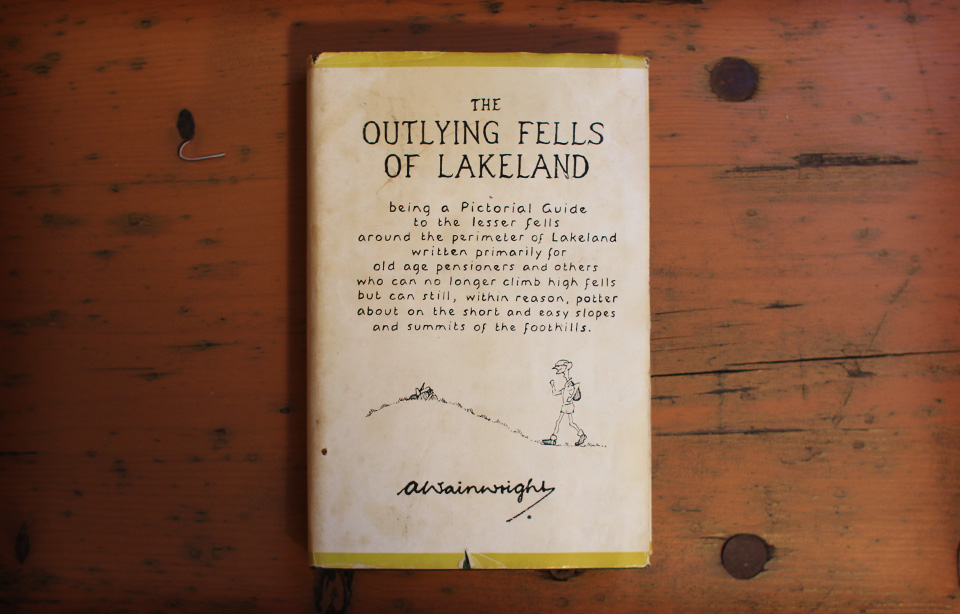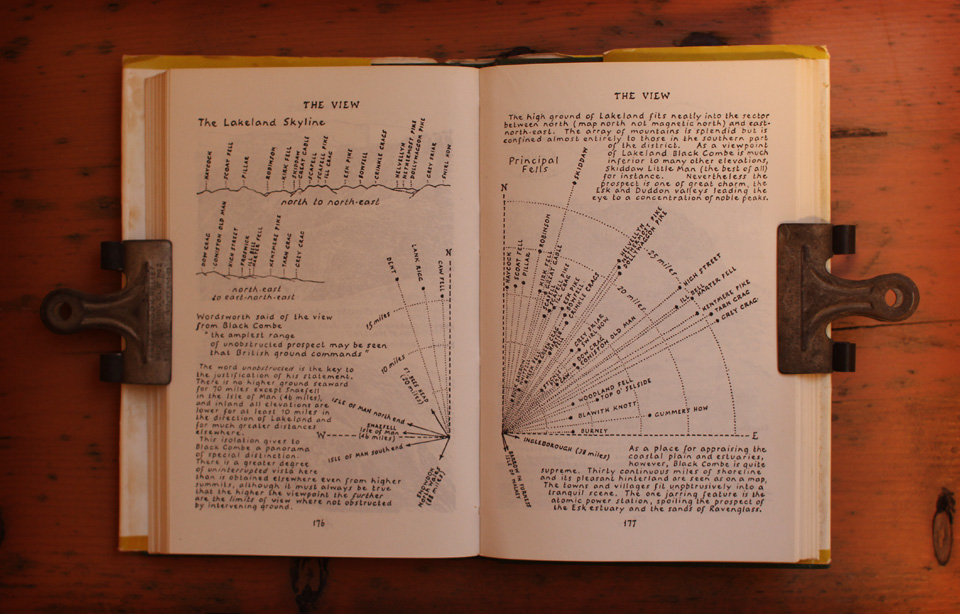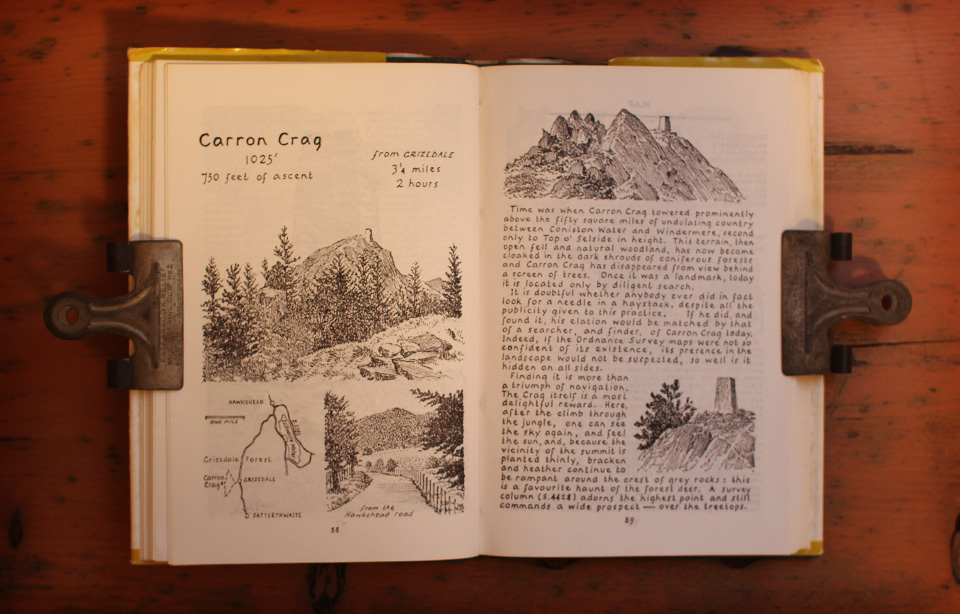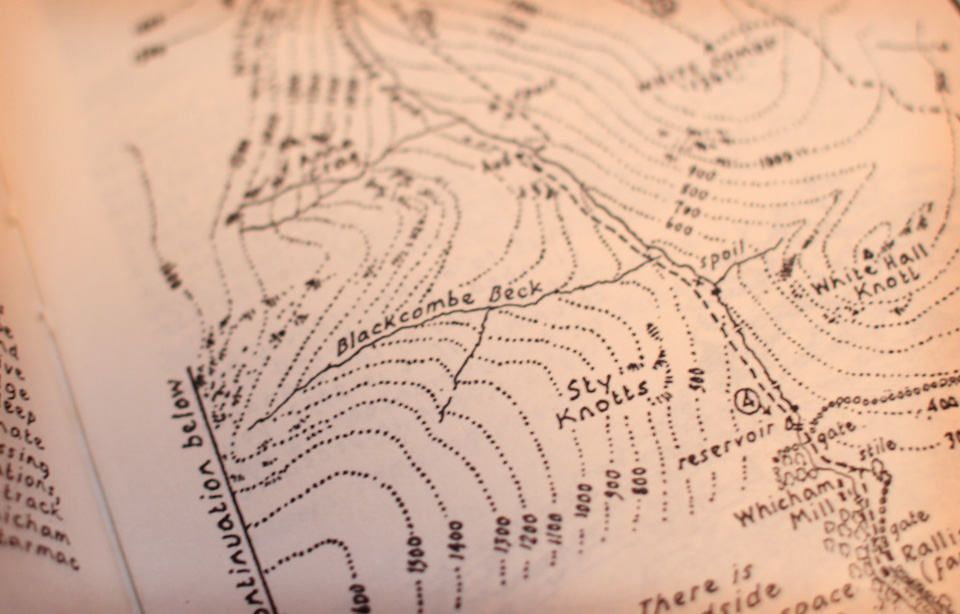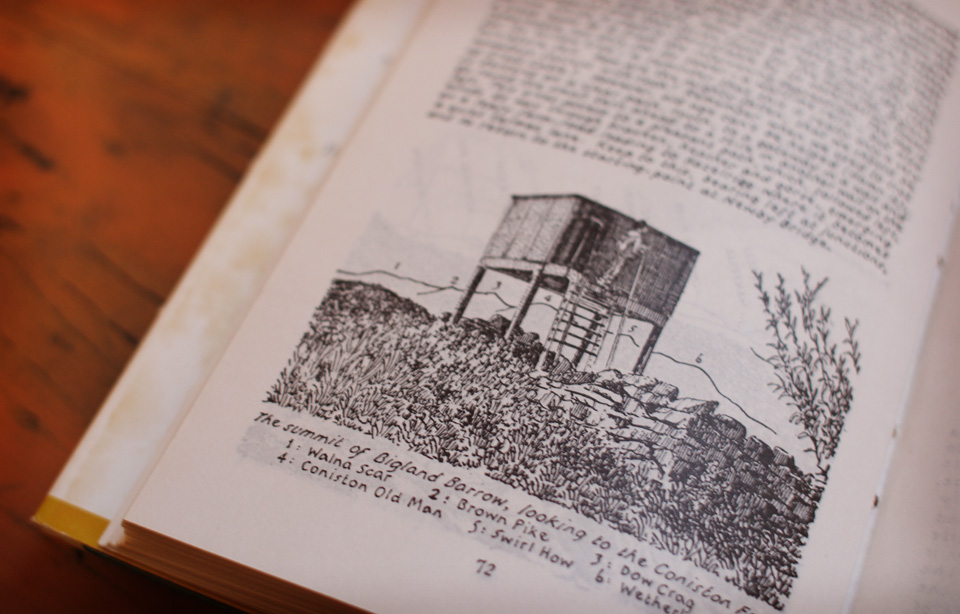I recently stumbled upon this wonderful series of maker videos from last years TedxBrighton. I particularly liked this talk given by EJ Osborne from Hatchet and Bear – philosophy through spoon carving. I love her energy and passion and the solace she's found in the simple pleasure of carving spoons. My brother has been the whittler in the family for a few years now but this certainly tempts me to get a hook knife and give it a crack. Enjoy.
Alfred Wainwright
There is no other character in British hiking quite as celebrated as Alfred Wainwright; although he is little known outside of the UK, for many he is the godfather of recreational walking. His pictorial guides to the hills and fells have made much of the UK, and in particular the Lake District, accessible for all to enjoy.
It all began on 7th June 1930. Wainwright had saved enough money for a weeks holiday in the Lake District in North-West England. He took the bus from his Blackburn home and after arriving in Windermere he made for Orrest Head; it is a short walk but ends with breathtaking views over the town of Windermere, the lake of the same name and the surrounding fells.
“I was totally transfixed, unable to believe my eyes. I had never seen anything like this. I saw mountain ranges, one after another, the nearer starkly etched, those beyond fading into the blue distance. Rich woodlands, emerald pastures and the shimmering water of the lake below added to a pageant of loveliness, a glorious panorama that held me enthralled.”
My trip to Orrest Head
From then on he was hooked, he spent the following years making multiple trips to explore the Lake District – he even found ways to make the journey during the early years of World War II, when travel was heavily restricted. So keen was his love of the area, that in 1941 he took a pay cut and moved north to Kendal to work for the Kendal Treasurer's Department. The hills were now on his doorstep and he ventured out at every opportunity, building a personal relationship and deep knowledge of their many peaks.
Being a meticulous scribe, illustrator and artist, as well as a passionate walker, Wainwright began to document each of his trips. In 1951 he began work on a set of Lakeland Guides, he intended to climb and document every one of the 214 Lake District's Fells. He completed this in 13 years and compiled them into seven books, once published they became instant classics, inspiring millions to load up a pack and head to the hills. Wainwright went on to expand his range, creating guides for the Pennine Way, the Coast To Coast walk and eventually the Lake District's Outer Fells, these have also become indispensable walking guides.
Each Wainwright guide is exquisite. Every publication is a compilation of his illustration and writing; of factual practical knowledge as well as his whimsical musings. If you chance upon any be sure to pick them up, even if you have no intention of visiting the Lake District – they are real works of art and an amazing case study in information design. His guides are now part of UK folklore, so much so that the 214 peaks in the Lake District are now known as 'Wainwrights'. The guides are still widely available and have been recently updated by Chris Jesty (a friend of Wainwrights) for Frances Lincoln who now has the publishing rights for the guides.
Sadly Alfred Wainwright passed away in 1991. He may have been quiet and reclusive in life, but his legacy does, and will, continue to speak loudly of his love for the hills and fells for years to come, through the practical content of his guides and in the memories created by the generations of walkers they inspired.
Chris Yates – The Lost Diary
Chris Yates talking about his lost diary
UPDATE: The book has been successfully funded so keep an eye out in the coming months!
I have spoken about Mr Yates in past posts - he is one of my favorite fishermen; he is beloved by nearly every British angler as an author, photographer and staunch advocate for vintage fishing gear and methods. Over the last few months, in anticipation for Maine's fishing season, I read a few of his books - each one is a masterpiece. I knew through Yates' reputation and his previous works that I would love these books, but as each one unfolded I became further charmed and impressed by Yates; his philosophies, his love for the outdoors, nature and, of course, tea. All of which resonate with me and my beliefs.
When I came to the end of "Nightwalk", Yates' magical and lyrical book about walking through nighttime British countryside, I was keen to find out what he was up to next. It was in this search that I came across his intended crowd funded next publication. Entitled "The Lost Diaries" the book is exactly that, a book of his recently rediscovered fishing diaries dating from the 1980s, including "the last days Chris spent fishing at Redmire after his record catch and the early days of the Golden Scale Club."
How to Fish and On Fishing at Sea
So for my sake, and for the sake of all those that love and cherish nature, the outdoors and Yates' writing, take a look at this video and perhaps consider donating to this book. Funding is being sourced through unbound.co.uk which is very much like kick-starter. For a minimum donation of GBP10 you will receive a copy of the book and also have your name published in the back.
So far I have read "How to Fish", "Nightwalk" and "On Fishing at Sea " these are still readily available and I cannot speak highly enough of them.
Paul Petzoldt
National Outdoot Leadership School History
Having read Paul Petzoldt's wonderful "Wilderness Handbook" I was familiar with his work with the National Outdoors Leadership School (NOLS), however I feel like I got a real insight into the great man from a set of videos filmed in the 1960s about NOLS. They give such a fascinating look into the roots of the school and into Petzholdt; his experience, passion and philosophy of the outdoors.
NOLS - Thirty Days to Survival
Petzoldt is a real hero, with a truly incredible resumé. In his youth he climbed extensively in the Grand Teton range and eventually founded the Petzoldt-Exum School of American Mountaineering in the 1930s. He spent time living in England which gave him the opportunity to climb in Europe, particularly in the Swiss Alps during the late 30s where he honed his skills and made a double traverse of the Matterhorn in one day with his climbing buddy Dan Bryant of New Zealand.
Petzoldt was selected to go on the first American expedition to K2, and during the Second World War he became a representative of the Department of Agriculture in Lend-Lease and then became a tutor to the troops of the U.S Army's 10th Mountain Division. After the war, he went on to teach thousands of youthful American's to love and thrive in the outdoors through the 'Outward Bound' program in Colorado in 1963, and then through the founding of NOLS in 1965. He was a true outdoors philosopher and pioneer, believing that youngsters should not be taught at, rather they should be involved in their own progression and learnings.
Sadly Petzoldt died in 1999, however his legacy lives in the people he inspired and through NOLS which still runs to this day. Thank you to NOLS for sharing these videos and for keeping his legacy alive.
Weston the Pedestrian
Edward Payson Weston
On 22 February 1861 Edward Payson Weston stood outside the State House in Boston, and with his sites set on Washington D.C., he strode forward on his first walk across America. This walk was undertaken as a result of a wager he placed on the 1860 presidential election. Weston lost by betting against Abraham Lincoln and as part of the terms of the bet he was to make an appearance at the swearing in of the new president. 10 days and 10 hours after setting off from Boston, having battled snow, rain and mud, he arrived in D.C. The media coverage his walk gained was the inspiration that led him to become one of the most famous pedestrians in American history.
Weston was born in Providence, Rhode Island on 15 March 1839. He served as a Union spy in the American civil war and, as the story goes, he developed his keenness for walking after having his horses shot from under him, forcing him to walk to deliver dispatches. This ability to walk paid dividends when he was employed as an office boy and eventually a reporter for the New York Herald - in a time before telephones and cars he was able to get to breaking stories before the competition.
Edward Payson Weston
Weston's second large walk was in 1867 from Portland, Maine to Chicago - a journey of 1200 miles which he covered in just 26 days. At this time he took part in many indoor and outdoor pedestrianism contests and even travelled internationally, spending 8 years in Europe challenging local walkers. In 1879 he defeated "Blower" Brown, the British champion, by walking a truly incredible 550 miles in 141 hours, 44 minutes in one of the "6 Day Races" at the Agricultural Hall, London, earning himself the famous Astley Belt. All the while he was spreading the word about the benefits of walking and cautioning people about the over use of the automobile and the perils of a sedentary life.
Over the following decades Weston achieved more super human walking feats. In April 1906 he walked 100 miles in less than 24 hours from Philadelphia to New York. In 1907 he repeated his walk from Portland, Maine to Chicago and shaved 24 hours off his original time. In 1909, at the age of 70, he walked the entire width of the United State; from New York to San Francisco a distance of 3,895 miles in 104 days 7 hours. He made the return journey the year after, covering 3,600 miles in 76 days, 23 hours and 10 minutes. His last big walk was in 1913 from New York to Minneapolis to lay a cornerstone of the Minneapolis Athletic Club, 1,546 miles which he covered in 51 days.
After so many high profile, incredible feats Weston slipped into obscurity. He became estranged from his wife and children and ended up in the care of his long time secretary Miss O'Hagen. In 1927, on the corner of 11th Street and 7th Avenue in New York City, he was struck by a taxi cab and never walked again. The motorcar, which he so vehemently rallied against in the promotion of a pedestrian lifestyle was the thing that eventually ruined him. It is said that he was rescued from poverty by the author Anne Nichols, who became his benefactress in his final years yielding him $150 per month to live on. He died of old age 2 years after the car accident.
So what makes Weston such a special character. To start with he was an incredibly accomplished athlete. He was one of the greatest walkers in the world and if he lived nowadays he would probably have sponsors and be on TV. Sadly, he has come to represent an obsolete ideal, a way of life that everyone has turned their back on. What he stood for seems almost quirky and twee, but at the time he was making a real stand and championing an alternate and legitimate lifestyle.
It would be hard now to repeat the routes that Weston took, sadly we now have to drive somewhere so that we can walk.
If you're interested in finding out more about Payson and the art of professional, long-distance walking, "Weston, Weston, Rah-Rah-Rah!" and "King of the Peds" by Paul S. Marshall and "Man in a Hurry" by Marshall, Nick Harris and Helen Harris are all great places to start.
Lt. Colonel Percival Harrison Fawcett
Lt. Colonel Percival Harrison Fawcett
I just started reading the excellent "Lost City of Z: A Tale of Deadly Obsession in the Amazon" a book by David Grann which follows the footsteps of Lt. Colonel Percival Harrison and his search for the fabled lost city. Fawcett was a distinguished British artillery officer, an accomplished archaeologist and possibly the greatest South American explorer of all time, another truly great adventurer with a truly great family motto. His disappearance in 1925 during an expedition to find "Z" is one of the true mysteries in exploration, inspiring countless others to trace his steps, many to their own demise.
“Nec Aspira Terrent. – “Difficulties be Damned” ”
The Leatherman
The Leatherman
This is one of those great stories, a piece of American folklore that intrigues and mystifies. It is a tale about a mysterious character called "The Leatherman" – a man who roamed the countryside in the mid 1800s. He wore a homemade suit constructed from the leather uppers of old boots with a matching leather hat and scarf, he rarely spoke but when when he did French appeared to be his first language. He spent a great many years traveling around New York, Massachusetts and Vermont before settling into a 365 mile loop around Connecticut and the Hudson River, which he completed every 34 days like clockwork. The Leatherman slept in caves where he stored supplies. He grew plants around his caves, foraged and picked up any supplies he needed from the towns along the way. His strict routine and odd look made him a familiar face along his route; newspapers even commented on his comings and goings. People were not afraid of The Leatherman and offered him aid where they could (although he never asked for it) and he came and went as his schedule dictated.
The Leatherman walked this same route for 6 years until he passed away on March 20, 1889 in Mt. Pleasant, New York. It is believed that he died from cancer and there are stories of him escaping forced hospitalization in order to return to his routine. He was such a well known character even the New York Times documented (rather imaginatively) his passing.
His body was buried in Sparta Cemetery on Route 9 in Scarborough, New York. The headstone read "FINAL RESTING PLACE OFJules Bourglay OF LYONS, FRANCE "THE LEATHER MAN" who regularly walked a 365 mile route through Westchester and Connecticut from the Connecticut River to the Hudson living in caves in the years 1858–1889." However, much of this epitaph was misinformed. His name was often reported as Jules Bourglay, but this and his apparent French origins we're based on an article written by the Waterbury Daily American in 1884,an article which they retracted.
In October 2010, the Westchester County Supreme Court granted permission to the Ossining Historical Society to exhume the Leatherman's body. They had controversially petitioned to get the Leatherman moved to "a safer and more dignified setting". They also planned to test the DNA of any remains found. However, the tale of The Leatherman took a final twist. When the grave was uncovered, all that was found was dirt and a few nails, no human remains. Nonetheless, the contents of the original grave were moved to the new site and a proper burial took place. The new resting place is marked by a headstone that simply says "The Leatherman."
So what is it about this story that people love? There is often a certain romance that comes with the story of a lone wanderer, a person striking out on their own in to the wilderness. But for me it's the mystique, who was the Leatherman? why did he choose walk that specific route? The lack of hard facts allows your imagination to take over. Was he a lonely, heart-broken soul. Was he just a very private person who loved the outdoors. There is so much that will never be answered, and so much for our minds to fill in, thus creating our own vision of what and who The Leatherman was.
I have been trying to write this article for about three months, trying to separate the fanciful from the factual. I've done my best to present The Leatherman in his true form but if I have missed anything please let me know.
Walt Whitman - Song of the Open Road
Walt Whitman
I'm a little embarrassed it has taken me this long to quote Walt Whitman, this is an excerpt is from "Song of the open Road" self published in Leaves of Grass, 1855. What an opening, it perfectly captures the giddy expectations and desires one gets when embarking on a grand journey. Enjoy.
“Afoot and light-hearted I take to the open road, Healthy, free, the world before me, The long brown path before me leading wherever I choose.
Henceforth I ask not good-fortune, I myself am good-fortune, Henceforth I whimper no more, postpone no more, need nothing, Done with indoor complaints, libraries, querulous criticisms, Strong and content I travel the open road.”
Hugh Glass
Hugh Glass
The last thing in life one wants to do is scare a bear with cubs. Worse still a grizzly bear, when alone, in a remote and hostile part of South Dakota. When the bear charges there is little left to do but rollover, play dead and await your fate. Well, unless your name is Hugh Glass.
Glass was a trapper in the 1800's and was attacked while scouting game for his expedition in Grand-River (presently Perkins Country). The story goes that before Glass could fire his rifle the bear was upon him, he drew his knife and fought the animal as it clawed him, ripping at his flesh and shredding his body.
Two fellow trappers ran to his aid and finished off the bear before attending to the mortally wounded Glass. When the expedition leader Andrew Henry arrived he found Glass unconscious. He had been ripped apart, had a broken leg, and gashes so deep that his ribs were exposed. There was no doubt he was a goner. Andrews asked for men to stay with Glass as he passed, and to give him a proper burial. Thomas Fitzpatrick and Jim Bridger volunteered to stay with him and bury the done-for mountain man when the time came. According to the men, after waiting some days they were disturbed by hostile Indians; panicking they grabbed Glass' rifle and equipment and ran for their lives. Glass was alone.
He lay there unconscious but not yet dead. After some time he began to stir and eventually regained consciousness. He was 200 miles from the nearest settlement of Fort Kiowa on the Missouri River. Furious at being left, the thought of revenge spurred him into action and he began his long crawl into American folklore. He set his own leg and tied his bearskin shroud around his exposed wounds. He lay across rotten logs to allow maggots to eat the dead flesh from his injuries, thus preventing them from going gangrenous. Fearing hostile natives he journeyed inland, crawling for six weeks, and surviving on berries, roots and scraps of meat stolen from startled wolves.
With aid from friendly natives and the help of a crude raft he built himself, Glass made it to Fort Kiowa alive and began his long recuperation. He eventually tracked down Fitzpatrick and Bridger but spared both their lives. He did however, reclaim his rifle and returned to the wilderness as a trapper and fur trader. Glass died in the winter of 1833 on the Yellowstone River during an attack by the Arikara.
This is just an incredible story! There has been so much written about this man in the form of both fact and fiction, and it is hard to separate the truth from the legend. Either way this is a great tale of pioneering America and legends they bore. There is now a monument to Glass at the site of the bear attack on the southern shore of Shadehill Reservoir, on the forks of the Grand River. If you ever get chance to visit doff your cap to Old Glass for me.
Cpt. Lawrence "Titus" Oates
Cpt. Lawrence Oates 17 March 1880 – 16 March 1912
Today marks 100 years since Cpt. Oates passed away, making the ultimate sacrifice to give his companions a better chance of survival. There are few stories as poignant and stirring as that of Cpt. Oates. I think it's important to give thought to this courageous man.
Portrait details. Captain Lawrence Edward Grace Oates during the British Antarctic Expedition of 1911-1913, ca 1911 Photographer: Herbert Ponting Reference Number: PA1-f-067-069-1 Silver gelatin print Photographic Archive, Alexander Turnbull Library

